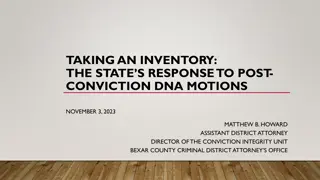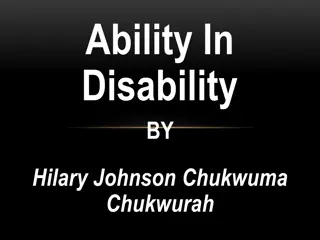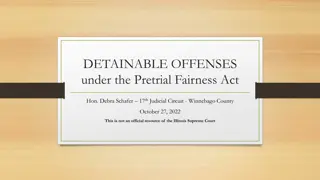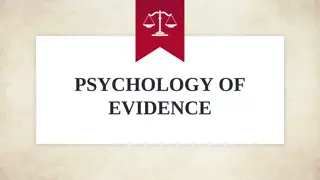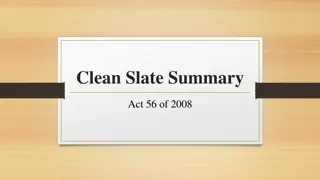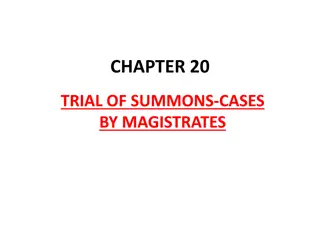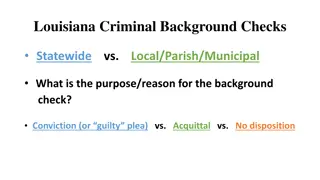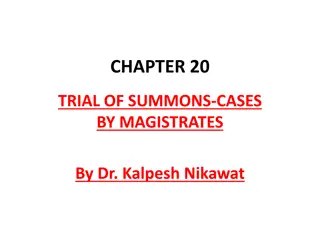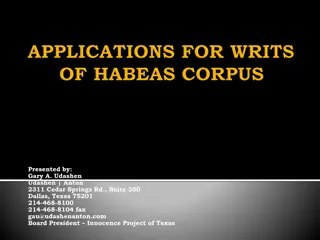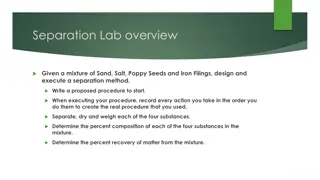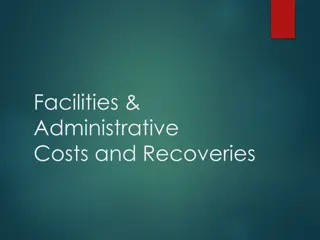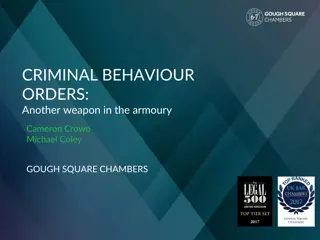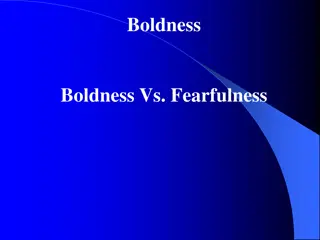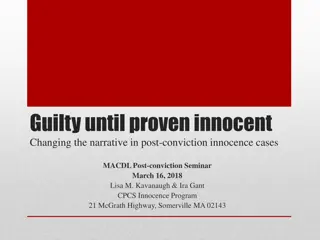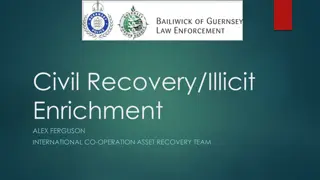
Confiscation and Asset Recovery: A Powerful Tool Against Crime
Understand the importance of confiscation and asset recovery in combating crime, the differences between property-based and value-based systems, and the purpose of these laws in removing the financial incentives behind criminal activities. Dive into the world of international cooperation and legal frameworks aimed at seizing illicit gains and disrupting criminal enterprises.
Download Presentation

Please find below an Image/Link to download the presentation.
The content on the website is provided AS IS for your information and personal use only. It may not be sold, licensed, or shared on other websites without obtaining consent from the author. If you encounter any issues during the download, it is possible that the publisher has removed the file from their server.
You are allowed to download the files provided on this website for personal or commercial use, subject to the condition that they are used lawfully. All files are the property of their respective owners.
The content on the website is provided AS IS for your information and personal use only. It may not be sold, licensed, or shared on other websites without obtaining consent from the author.
E N D
Presentation Transcript
1 Conviction Based Recoveries ALEX FERGUSON ASSET RECOVERY LAWYER INTERNATIONAL CO-OPERATION ASSET RECOVERY TEAM - GUERNSEY
2 Background Proceeds of Crime legislation is a vital tool in the fight against crime as it strikes at the main motivation for the commission of crime, namely money. The basic principle that underlines proceeds of crime legislation is that crime should not pay and this should be at the forefront of all investigations and prosecutions. This principle should apply whether the individual is a burglar, a drug dealer, a money launderer or a sophisticated fraudster. Crime and in particular organised crime is a worldwide problem that is driven by money. The effect on economies can be dramatic. The National Fraud Authority, Annual Fraud Indicator (AFI) report 2012 suggests that fraud alone is costing the United Kingdom around 73 billion a year. This figure does not include other crime such as drug trafficking, human trafficking and terrorist financing.
3 What is confiscation? Confiscation can be either property based or value based: Property-based systems (also referred to as tainted property or forfeiture systems) allow the confiscation of assets found to be the proceeds or instrumentalities of crime, requiring a link between the asset and the offence (a requirement that can be difficult to prove when assets have been laundered, converted, or transferred to conceal or disguise their illegal origin). Value-based systems allow the determination of the value of the benefits derived from crime and the confiscation of an equivalent value of assets that may be untainted. Some jurisdictions use enhanced confiscation techniques, such as substitute asset provisions or legislative presumptions to assist in meeting the standard of proof
4 Confiscation/Forfeiture It is a common misconception that confiscation and forfeiture are the same. There are distinct differences between them: A forfeiture order is in rem it attaches against tainted property A confiscation order is in personam it is an order against the person
5 Confiscation/Forfeiture The advantage of a forfeiture order is that it attaches to the property and once the order is made the property is transferred to the State. However this order can only be made in respect of tainted property i.e. that was used in an offence, was going to be used in the commission of an offence or was derived from an offence. In comparison value based confiscation allows the court to go much further in assessing the defendant s benefit from the offence/s for which he was convicted and also from his general criminal conduct often referred to as his criminal lifestyle .
6 What is the purpose of confiscation? Whenever you read a case report or an article on Proceeds of Crime and asset recovery the author will comment in the introduction on the benefit of this law: A proceeds of crime recovery run properly, not only removes from the hands of a criminal their ill gotten gains, but also sends out a healthy signal to decent right minded people that crime does not pay. The removal of money and assets obtained through unlawful conduct from criminals can be fed back into worthwhile causes such as an effective criminal justice system, hospitals and schools. A well run, well thought out, asset recovery scheme should be self funding.
7 Value based confiscation orders what are they? It is a monetary order made by a court to represent the benefit obtained by a criminal from committing an offence or offences Separate to the benefit calculation the court has to determine what realisable assets the defendant has and their value. If he has assets that are equal to the benefit the order will be made in that amount. If they are less the order will be made equal to their value.
8 Benefit from criminal conduct Within Proceeds of Crime legislation there are two types of criminal benefit: Benefit from particular criminal conduct (simple benefit); Benefit from general criminal conduct (aggravated benefit or criminal lifestyle)
9 Benefit from particular criminal conduct A common definition of benefit from particular criminal conduct: Where a person obtains property as the result of, or in connection with the commission of an offence, his benefit is the value of the property so obtained. Where a person derives an advantage as a result of or, in connection with the commission of an offence, his advantage shall be deemed to be a sum of money equal to the value of the advantage so derived.
10 To determine whether a defendant has benefitted from his particular criminal conduct the court will: Examine the evidence from the trial; or the prosecution case to which the defendant has pleaded guilty; AND Determine whether the defendant obtained any: a) property; or b) pecuniary or quantifiable advantage.
11 How is the value of property calculated? In determining the value of the property obtained the court is required to apply the market value. Difficulties have arisen in cases where the defendant has been found in possession of illicit goods such as controlled drugs or counterfeit goods. As these good have not got a legitimate market how can a value be placed on them? If it can, what value? R v Islam [2009] R v Mejia & Smeath [2009] EWCA (Crim) 1940 Elsayed [2014] EWCA Crim 333
12 Cases Re J The Times, 12 July 2005 , the Court of Appeal held that to obtain does not mean to retain. R v David Kai Xu [2008] EWCA (Crim) 2372 - the defendant was convicted of offences contrary to immigration law as he had employed illegal immigrants in his restaurant. The illegal immigrants made up a quarter of the workforce. The proper amount of the confiscation order was calculated to be a quarter of the total receipts of the business over the period that the illegal immigrants were employed. As the defendant had not been forthcoming with details, it was open for the court to take a robust approach in inferring that the employees did make a significant difference to the amount of receipts of the business. NB it was the receipts that made up the confiscation order and not the profits.
13 Pecuniary advantage In determining whether a defendant has benefitted from the offences for which he was convicted the court also has to consider whether he has obtained a pecuniary advantage. Example: Where a defendant uses money obtained as a result of his crime to invest in property, bonds or shares and there is an increase in their value, that new value of the property into which the criminal proceeds were invested becomes the proceeds of crime. Similarly in a case where a defendant has obtained property as a result of mortgage fraud, rental income from those properties will be included as a pecuniary advantage
14 Benefit from general criminal conduct In addition to considering the benefit from the offences for which a defendant has been convicted, Proceeds of Crime legislation also allows a court to consider whether the defendant has benefitted from his general criminal conduct. To do this the court is able to make certain assumptions that property held, obtained or expenditure made by the defendant during the period of 6yrs prior to the confiscation hearing have come from crime.
15 The assumptions The court is required to make three assumptions: 1. All property held by the defendant in the period of 6yrs up to and including the date of the confiscation hearing has come from his criminal conduct; 2. Any expenditure incurred by the defendant in the period of 6yrs up to and including the date of the confiscation hearing has been met out of the proceeds of his criminal conduct; 3. Whenever the defendant has received property the assumption is that he obtained that property free of any interest in it.
16 Cases R v Jones [2006] EWCA (Crim) 2061 - A defendant is not able to claim that assumptions made in relation to his expenditure and income is likely to result in a serious injustice if the Court decides to apply the assumptions in full. Without an evidential basis to conclude otherwise there is no injustice in applying the assumptions. R v Jhalman Singh [2008] EWCA (Crim) 243 this case dealt with the calculation of benefit from a course of criminal conduct and whether there was a serious risk of injustice. Held that there was no risk of injustice in applying the assumptions in this case, ..if people chose to operate their business dealings only in cash and kept no records of any kind whatsoever they had to take the consequences that might arise for the purposes of the potential application of the legislation.
17 Calculating the amount of benefit The court has to determine the value of: The property obtained; Any advantage; Any property or expenditure caught by the assumptions
18 Realisable amount Once the court has determined the extent of the defendant s benefit; it then has to consider the value of the realisable property held by the defendant. If this is equal to the benefit figure then the confiscation order should be made in this amount. If the value of the realizable property is less than the benefit figure then the confiscation order should be made equal to the value of the realizable property. Included in this calculation would be any assets that have been transferred to a third party and where the prosecution alleges that they are a gift.
19 Other statutory provisions to assist with confiscation Investigative powers: Search and seizure warrants; Production orders; Customer information orders; Disclosure orders Monitoring orders (s48).
20 Other Statutory Provisions Restraining orders/Freezing orders The purpose of the order is to ensure that there is property available to satisfy a forfeiture and or confiscation order. Unlike a freezing order a restraining order does not attach to property, it prevents a defendant or other named parties from disposing of or otherwise dealing with property
21 Any Questions?



